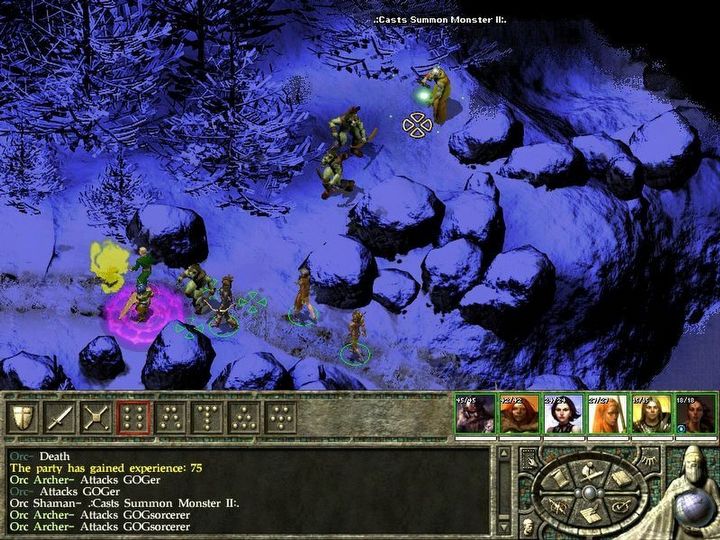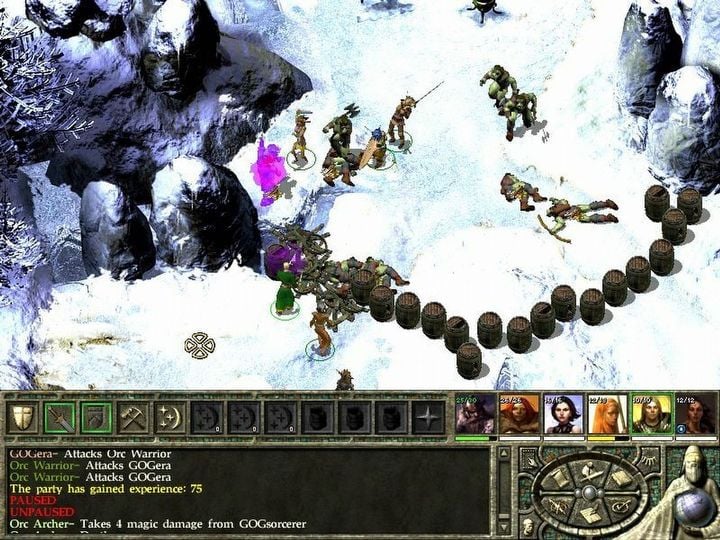
The original Icewind Dale was a success, despite being more streamlined than Baldur’s Gate. It took inspiration from games like Diablo, focusing more on action and dungeon exploration than a complex story, though it still offered a good narrative. It appealed to fans of classic isometric RPGs with its beautiful winter scenery, engaging side quests, and surprisingly charming characters—even though you created them yourself. The game was also greatly enhanced by the memorable music composed by Jeremy Soule.
The second game was developed quickly, and while it was considered a good sequel, many felt it lacked the intensity of the original. It also faced tough competition from newer 3D games like Morrowind and Neverwinter Nights. In retrospect, that assessment was wrong. Icewind Dale 2, one of the final games from Black Isle Studios – along with Baldur’s Gate: Dark Alliance 2 – is a truly great 2D RPG. If you play it with an open mind, you’ll find it’s surprisingly spirited and edgy.

Return to Icewind Dale
I was a little disappointed when I first played Icewind Dale 2. The original game really drew me into the world of the Infinity Engine, but the sequel didn’t have the same sense of mystery and personal adventure as it took me through the frozen landscapes. While the music was clearly inspired by the fantastic score of the first game, it felt a bit too grand and bombastic – almost like something Inon Zur would compose. Everything initially seemed overly dramatic and lacked subtlety.
The first Icewind Dale game begins with a group of adventurers traveling to Kuldahar, a town built around a massive oak tree, to investigate some problems. It had a straightforward but appealing story that unfolded at a comfortable pace between exploring dungeons. Icewind Dale 2 jumps right into the thick of things, starting in the town of Targos, which is under attack. You’re tasked with helping the residents defend against the Legion of the Chimera—a fearsome force led by goblins and orcs.
The game initially appears straightforward – you manage a team of up to six mercenaries. However, you quickly discover the story has surprising depth, thanks to the writers at Black Isle. While it’s a conflict between two sides, the quests are exceptionally well-written, often with humor and a sharp edge, and the main plot is surprisingly complex. The opposing group, the Legion of the Chimera, aren’t simple villains; they have understandable reasons for their actions. The story explores themes of alienation and feeling like an outsider, offering some genuinely touching narratives about those who struggle to find their place.
Players coming from complex RPGs like Baldur’s Gate 2 or Planescape: Torment might find this game’s story and characters less developed. However, if you approach it with adjusted expectations, the writing is surprisingly good for the genre, offering clever dialogue and humor.
As a fan, I really have to give it up to the designers! They built such a long, detailed, and varied campaign, full of interesting challenges, and they did it even with a tight budget and limited time. It’s honestly amazing how well it holds up even now.

Dungeons & Dragons 3.0 magic
The game’s core systems are still solid and actually more intricate than the original Icewind Dale, even with the Heart of Winter expansion. Older games built on the same engine used the Advanced Dungeons & Dragons ruleset, which, while classic, was fairly restrictive – you picked your character’s race, class, gender, and alignment, rolled some dice for stats, and that was mostly it.
Like Neverwinter Nights, Icewind Dale 2 used the highly customizable rules of the third edition of Dungeons & Dragons, and it felt incredibly liberating at the time. Players had much more freedom in developing their characters with skills and abilities that even impacted conversations. While Icewind Dale 2 didn’t emphasize this quite as much as Neverwinter Nights, it was still a feature. Importantly, every character race could combine classes as they leveled up, letting players create unique and sometimes game-breaking builds. This added a lot to the game’s appeal.
Unusual character builds, like focusing on a stat called Trak0 or intentionally having a very low armor class, aren’t really a thing anymore – though I always enjoyed trying to make those work! This version of the game does offer a lot more character options, with many different races and sub-races like dark elves, which gives players more freedom to experiment and get into roleplaying.

Old school
Technically, the game was a traditional 2D title featuring beautiful, hand-drawn backgrounds and appealing visual effects. The character animations were simple but cute, though they didn’t quite match the quality of the detailed character portraits. Combat was frequent and memorable, and involved characters taking turns attacking each other with weapons or spells. While it appeared to happen in real-time, the game actually paused during each turn to allow for strategic decisions.
Battles were really fun, thanks to the detailed rules from the third edition of Dungeons & Dragons and the cleverly designed levels, traps, and encounters. This was especially true for players who loved the strategic, top-down combat style of games like those made with the Infinity Engine.
Speaking of this game, it’s worth remembering that for a long time, it was the last one made using the Infinity Engine. That is, until Beamdog came along and released both Baldur’s Gate: Siege of Dragonspear and the Enhanced Edition versions of the older games. Interestingly, Icewind Dale 2 never received an official Enhanced Edition. So, if players want a more polished experience than the original, they have to turn to mods and fan-made patches. Thankfully, there are plenty of those available. I particularly enjoyed the NPC Project, which adds new companions with unique backstories, conversations, and personalities. I also checked out the fan-made Enhanced Edition project, and it’s surprisingly good.

How to play Icewind Dale 2 today?
While an official updated version doesn’t exist – only a fan-made one – you can still buy the original complete game on GOG for just nine dollars. Or, if you prefer physical copies, you can search for older boxed versions if you’re a collector.
If you’re looking for a classic Dungeons & Dragons experience, or want to revisit a beloved game as its creators originally envisioned, Icewind Dale 2 is definitely worth playing. It remains a fantastic, old-fashioned RPG that provides simple, enjoyable gameplay and countless hours of adventure in a beautiful, icy fantasy setting. It’s a straightforward and rewarding experience.
Read More
- The X-Files’ Secret Hannibal Lecter Connection Led to 1 of the Show’s Scariest Monsters Ever
- Is The White Lotus Breaking Up With Four Seasons?
- Fan project Bully Online brings multiplayer to the classic Rockstar game
- Clayface DCU Movie Gets Exciting Update From Star
- Yakuza: Like a Dragon joins the PlayStation Plus Game Catalog next week on October 21
- Dad breaks silence over viral Phillies confrontation with woman over baseball
- Elizabeth Olsen Wants to Play Scarlet Witch Opposite This MCU Star
- One Battle After Another Is Our New Oscar Front-runner
- EUR TRY PREDICTION
- Dwayne ‘The Rock’ Johnson says “we’ll see” about running for President
2025-11-09 11:33